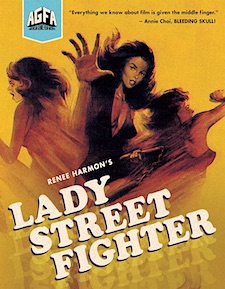Lady Street Fighter (Blu-ray Review)

Director
James BryanRelease Date(s)
1981 (August 14, 2018)Studio(s)
James Bryan Productions/IFI/Scope III (American Genre Film Archive)- Film/Program Grade: D
- Video Grade: C+
- Audio Grade: C+
- Extras Grade: C-
Review
I find it difficult to grade something like Lady Street Fighter, that is to say, grade it based upon any sort of serious criteria. It’s not a good film in the traditional sense as it operates in its own weird, unique way. It’s like the missing link of movies, not totally functional but fascinating and bizarre to witness. From inventing a fake actor credit in order to fulfill a producer’s request to have a “name” in the cast to putting a 50-year-old, eastern European actress (Renee Harmon) in the main role as an asskicking lady of the night-type who’s out for revenge against the mobsters who tortured and murdered her sister, it’s a healthy slice of extreme whatthefuckery, the likes of which doesn’t come along all that often.
James Bryan, who most horror fans know as the director of Don’t Go in the Woods, helmed this early 1980s actioner, which was shot several years prior under a different title and eventually released under the title Lady Street Fighter to capitalize upon the Asian exploitation boom of the late 1970s. As the movie’s story unfolds, it gets increasingly difficult to understand who is who and what’s going on. In between random scenes of action is a semi-love story subplot that ultimately goes nowhere, not to mention an extended sequence in a strip club, and a protracted moment at a party when our lead grinds her heels into her host with a whip in her hands. So there isn’t much in the way of lady street fighting to be had, only occasionally.
Its aesthetic and execution often defy description, but the film also seems to be assembled from various angles that don’t really cut together, which is likely because they weren’t meant to be connected in the first place. On top of all of that is a character who is either meant to a 5-year-old girl or a grown woman with a disability, but it’s not all that clear which is correct. One also can’t forget the use of a low grade dance remix of the theme from The Good, The Bad and The Ugly, which plays constantly throughout the film during scenes of constant narrative and character flip-flopping. In essence, it’s a mess, but an intriguing one.
One has to wonder why the sequel, Return of the Lady Street Fighter (which is promised during the end credits), never came into being... or perhaps it’s perfectly clear why. Regardless, there’s little that makes sense about Lady Street Fighter. It’s one of those films that you will either revel in how poorly made and entertaining it is or discard it outright as a failed piece of cinema. No matter which side of the fence you’re on, it’s at the very least memorable.
AGFA continues its line of undervalued and little seen cult titles, giving Lady Street Fighter a 4K scan from the only-known surviving 35mm theatrical print of the film. If you’re familiar with AGFA’s previous high definition output, you pretty much know what you’re in for here. It’s not a pristine presentation by any means, but it’s entirely film-like and natural, complete with leftover damage, which includes scratches, tears, and speckling throughout, as well as some discoloration. However, some color correction has been applied to fix as much as possible, so what is present is aesthetically appropriate for the era in which it was shot. Grain, although heavy, is solid and the frame is stable throughout, while everything appears perfectly bright and clear. As it takes place primarily during the day, you definitely know what’s going on at all times as nothing appears overly murky (the party scene being the exception, which carries some abundantly built-in crush). The audio is included in English 2.0 mono DTS-HD with optional subtitles in English SDH (which might be crucial if you want to understand everything that Renee Harmon is saying). As it’s a poorly put-together film, the dialogue isn’t always front and center. The track itself contains plenty of leftover damage including hiss, crackle, and occasional drop-outs and the overall sound quality is boxy and muffled as well. Again, this isn’t necessarily a film that lends itself to a superb presentation, but what’s included is well-representative of the material.
The extras are fairly brief, but you do get a very good audio commentary with director James Bryan and the AGFA team (Joe Ziemba and Sebastian del Castillo) as moderators, which is actually more entertaining than the film itself as it goes into detail about it, with Ziemba in particular being quite excited and enthusiastic; a set of Street Fightin’ Trailers from the AGFA vaults, which includes Force: Five, Four Four (AKA Black Force), Zebra Force, The Muthers, and Sister Street Fighter; a bonus movie, Revenge of Lady Street Fighter, which is on par presentation-wise with its predecessor and is mostly the same film again but with re-ordered scenes and a new plot about lady street fighter’s niece being questioned by the F.B.I.; and last but not least is a 12-page insert booklet with the essay “Get Out of Her Way: The Legacy of Lady Street Fighter” by Annie Choi, as well as restoration details about both films.
Lady Street Fighter is on the same level as The Room, but without the budget. It’s a madcap clutter of insanity with a leading actress who doesn’t speak English that well and a multitude of plots and horrendous acting that must be seen to be believed. AGFA’s treatment of the title is shockingly good, making it a cult title that’s still waiting to be discovered by the majority of modern film fans. Whether you’re into good/bad movies or you want something completely out of the norm, Lady Street Fighter comes recommended either way.
- Tim Salmons

